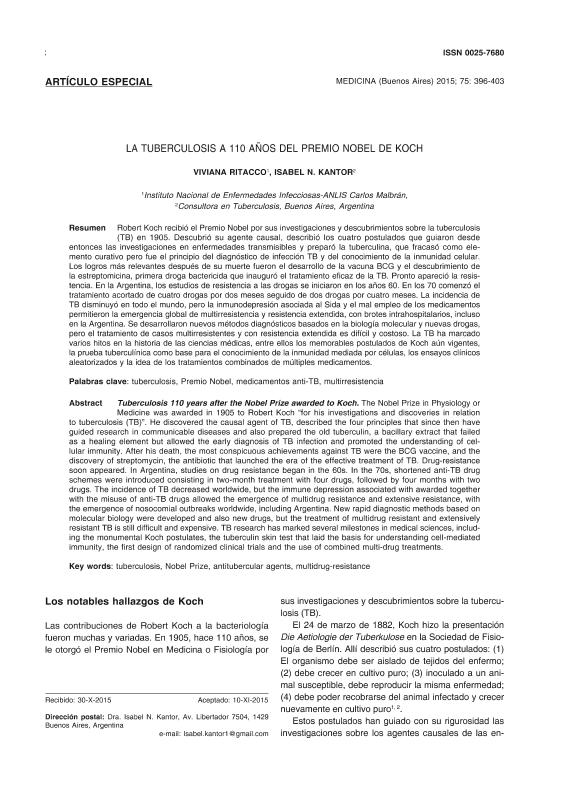Artículo
Robert Koch recibió el Premio Nobel por sus investigaciones y descubrimientos sobre la tuberculosis (TB) en 1905. Descubrió su agente causal, describió los cuatro postulados que guiaron desde entonces las investigaciones en enfermedades transmisibles y preparó la tuberculina, que fracasó como elemento curativo pero fue el principio del diagnóstico de infección TB y del conocimiento de la inmunidad celular. Los logros más relevantes después de su muerte fueron el desarrollo de la vacuna BCG y el descubrimiento de la estreptomicina, primera droga bactericida que inauguró el tratamiento eficaz de la TB. Pronto apareció la resistencia. En la Argentina, los estudios de resistencia a las drogas se iniciaron en los años 60. En los 70 comenzó el tratamiento acortado de cuatro drogas por dos meses seguido de dos drogas por cuatro meses. La incidencia deTB disminuyó en todo el mundo, pero la inmunodepresión asociada al Sida y el mal empleo de los medicamentos permitieron la emergencia global de multirresistencia y resistencia extendida, con brotes intrahospitalarios, incluso en la Argentina. Se desarrollaron nuevos métodos diagnósticos basados en la biología molecular y nuevas drogas, pero el tratamiento de casos multirresistentes y con resistencia extendida es difícil y costoso. La TB ha marcado varios hitos en la historia de las ciencias médicas, entre ellos los memorables postulados de Koch aún vigentes, la prueba tuberculínica como base para el conocimiento de la inmunidad mediada por células, los ensayos clínicos aleatorizados y la idea de los tratamientos combinados de múltiples medicamentos. The Nobel Prize in Physiology or Medicine was awarded in 1905 to Robert Koch “for his investigations and discoveries in relation to tuberculosis (TB)”. He discovered the causal agent of TB, described the four principles that since then have guided research in communicable diseases and also prepared the old tuberculin, a bacillary extract that failed as a healing element but allowed the early diagnosis of TB infection and promoted the understanding of cellular immunity. After his death, the most conspicuous achievements against TB were the BCG vaccine, and the discovery of streptomycin, the antibiotic that launched the era of the effective treatment of TB. Drug-resistance soon appeared. In Argentina, studies on drug resistance began in the 60s. In the 70s, shortened anti-TB drug schemes were introduced consisting in two-month treatment with four drugs, followed by four months with two drugs. The incidence of TB decreased worldwide, but the immune depression associated with awarded together with the misuse of anti-TB drugs allowed the emergence of multidrug resistance and extensive resistance, with the emergence of nosocomial outbreaks worldwide, including Argentina. New rapid diagnostic methods based on molecular biology were developed and also new drugs, but the treatment of multidrug resistant and extensively resistant TB is still difficult and expensive. TB research has marked several milestones in medical sciences, including the monumental Koch postulates, the tuberculin skin test that laid the basis for understanding cell-mediated immunity, the first design of randomized clinical trials and the use of combined multi-drug treatments.
La tuberculosis a 110 años del Premio Nobel de Koch
Título:
Tuberculosis 110 years after the Nobel Prize awarded to Koch
Fecha de publicación:
12/2015
Editorial:
Medicina (Buenos Aires)
Revista:
Medicina (Buenos Aires)
ISSN:
0025-7680
e-ISSN:
1669-9106
Idioma:
Español
Tipo de recurso:
Artículo publicado
Clasificación temática:
Resumen
Palabras clave:
Tuberculosis
,
Premio Nobel
,
Postulados de Koch
Archivos asociados
Licencia
Identificadores
Colecciones
Articulos(SEDE CENTRAL)
Articulos de SEDE CENTRAL
Articulos de SEDE CENTRAL
Citación
Ritacco, Gloria Viviana; Kantor, Isabel N.; La tuberculosis a 110 años del Premio Nobel de Koch; Medicina (Buenos Aires); Medicina (Buenos Aires); 75; 12-2015; 396-403
Compartir




